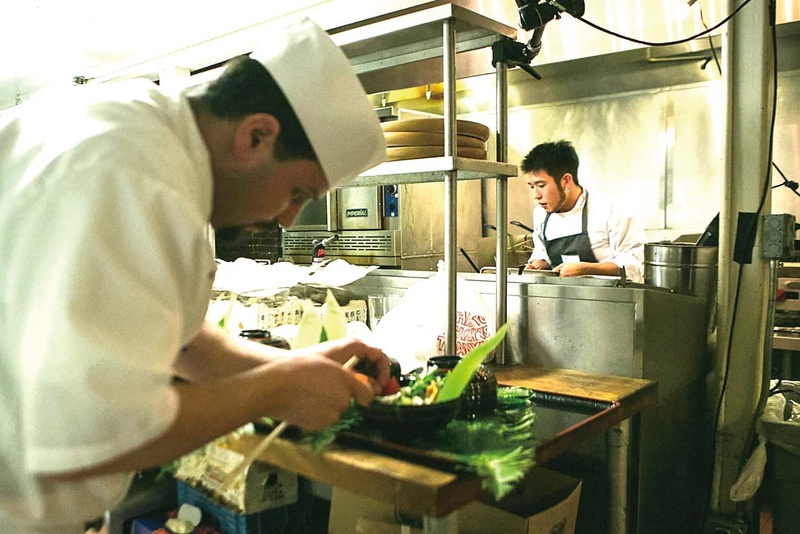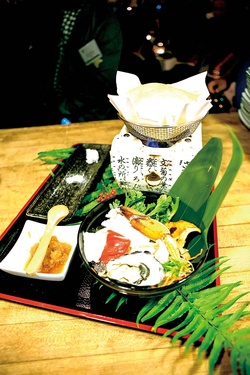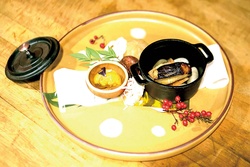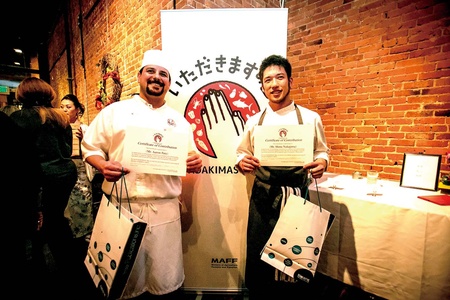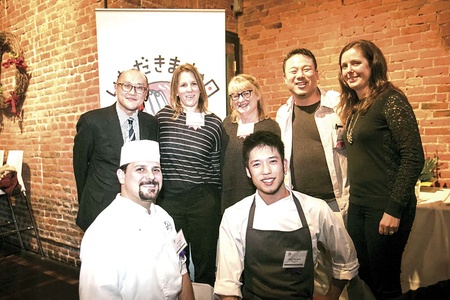With cooking competitions becoming widely popular on TV and at community events, Seattle became a center for a Japanese cuisine chefs’ kitchen battle last month. “Washoku World Challenge 2015” hosted a Seattle event on December 11 in Pioneer Square.
Organized by Japan’s Ministry of Agriculture, Forestry and Fisheries and Nikkei Business Publication, the event focused on competition by foreign chefs of Japanese cuisine who serve quality dishes to local customers.
The event organizer picked three cities from three regions, Seattle from North and South America, Jakarta from Asia, and London in Europe, considered as cities with rising potential for Japanese cuisines.
Eligible chefs are foreign citizens in Japan and those who were born outside of Japan. Looking for a deep understanding of Japanese cuisine, the organizer picked two chefs including Aaron Pate from Shiro’s Sushi Restaurant in Belltown and Shota Nakajima of Kappo Kitchen, a local Japanese food catering company.
Pate was born in Hawaii and trained and worked at Japanese restaurants in Hawaii and Japan prior to his current position. Nakajima, a local-born Japanese American, learned the depth of Japanese cuisine at Tsuji Culinary School in Japan at age 18 and later trained under a Michelin star chef in Osaka.
The competition set 30 minutes for cooking, three minutes for presentation, and 10 minutes for a Q&A session from five judges selected by local and event representatives. Presentation, matching the theme, understanding of Japanese culture and cuisine, flavor, and originality were the five criteria being judged.
As the United State is the largest Japanese sake importer, the theme was to cook a dish matching Japanese sake using local and seasonal ingredients. Pate cooked “Tonyu Kaisen (soy milk seafood) Shabu-shabu” while Nakajima introduced “Hatsuyuki Hassun” featuring eight elements of Japanese food on a plate.
The event, titled “Itadakimasu Day,” drew about 150 locals for the cooking competition and the recognition of Japanese cuisine chefs who have introduced quality Japanese food and culture to Seattle. After the judging, Nakajima was named as the Seattle representative to compete against other chefs in Kyoto at the end of January.
Representing the organizer, Kenji Toda, chief editor of Nikkei Restaurant, said that both chefs shared good spirits and techniques with their dishes.
Growing up in a Japanese family, Nakajima said that he was influenced by his mother’s homemade dishes using local ingredients.
“Enjoyment of food is a big part of our life,” said Nakajima, who dreams of having his own restaurant. “I want to show more varieties of Japanese cuisine. From a kitchen, it would be great to explain and share the details, which will be fun.
For his next challenge in Kyoto, Nakajima also said, “I hope I put everything I learned into this challenge.”
While not chosen for the Kyoto tourney, Pate added that he had a great experience and was motivated to improve his skills in preparation for the next opportunity.
Japanese Cuisine brought to a new level
According to the event organizer, the number of Japanese restaurants abroad has reached 55,000, twice as much as it was three years ago. With Japanese food culture added to the UNESCO’s world heritage in 2013, many cities and organizations began hosting and promoting events to feature Japanese cuisine. This has also helped Japan recognize its heritage and understand its cuisine despite an increasingly Western society.
“We understand that there are many foreign chefs who understand well and introduce real Japanese cuisine to locals,” Toda said. “We want to find more talented chefs who are not known yet.”
Toda said that Seattle has a variety of local foods, thanks to weather and nature, that has been helpful for the Japanese food boom.
“I recognized how much local residents have been enjoying Japanese food,” he said. “This is amazing. I don’t think this is noticed by people in Japan yet, but this will be a great news and opportunity to know for them.”
Some chefs stated that Seattle has a unique food culture, having grown up together with chefs and customers under a variety of local ingredients and diverse cultures.
“Here in Seattle, real Japanese food has been enjoyed by local Americans,” said Taichi Kitamura of Sushi Kappo Tamura and chief judge of the event. “I think Seattle’s Japanese cuisine has been leveled up by local American customers, unlike large cities, which can expect more Japanese customers.”
Nikkei & Japanese Abroad Conference Features Washoku
The 55th Nikkei & Japanese Abroad Conference in Tokyo last October discussed the depths of Japanese culture abroad including how Japanese cuisine is internationally recognized, reported Sam Takahashi of Washington Coordinators, Inc.
The conference resolution, according to Takahashi, included the following statement:
“Overseas Japanese who endeavor for the success of Japanese culture are proud of Washoku culture which is well accepted in foreign countries and continues to evolve while polishing up creativity to go on. Washoku for us is a taste of an old home we cannot forget.
We came through difficult times to find and develop food materials to be used that felt similar to Washoku. As time went by, local people were interested in such Washoku-like food and it greatly helped the understanding of Japanese culture. We found that Washoku can be a strong tool to introduce Japanese culture and now it is accepted without feeling out of place, thus, it is evaluated highly in the world.
The position of Japanese and Nikkeijin living overseas is not necessarily to recreate authentic Japanese food but rather to create Japanese food based in the local community by using locally available food materials and contribute to add flavor to Japanese festivals and celebrations at home with family and friends. Such effort will contribute to promote Japanese culture.
It is our pride that Washoku was registered as an Intangible World Cultural Heritage. We respect true authentic Washoku culture and create Washoku to fit in each country reflecting our imagination.”
Editor’s note: Aaron Pate of Seattle’s Shiro’s Sushi restaurant will compete in the final round at the Washoku World Challenge 2015 due to the disqualification of Mr. Nakajima.
* This article was originally published on The North American Post on January 1, 2015 (Vol. 70, issue 1&2). Photo courtesy of http://suzi-pratt.com
© 2015 The North American post


